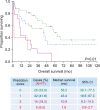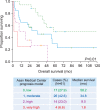Primary central nervous system lymphoma: a new prognostic model for patients with diffuse large B-cell histology
- PMID: 29333405
- PMCID: PMC5762739
- DOI: 10.5045/br.2017.52.4.285
Primary central nervous system lymphoma: a new prognostic model for patients with diffuse large B-cell histology
Abstract
Background: Age and performance status are important prognostic factors in primary central nervous system (CNS) lymphoma. Although several prognostic models have been proposed, there is no consensus on the optimal model for patients with diffuse large B-cell histology.
Methods: Seventy-seven patients with primary CNS diffuse large B-cell lymphoma were retrospectively analyzed to determine factors affecting survival. Three Western models were applied to our eligible patients; we devised a novel model based on our findings.
Results: The median patient age was 59 years (range, 29-77); the median event-free and overall survival (OS) durations were 35.9 and 12.6 months, respectively. Nottingham/Barcelona and Memorial Sloan Kettering Cancer Center models were applicable to our cohorts. Multivariate analysis showed that advanced age, multifocal lesions, and high cerebrospinal fluid (CSF) protein concentrations were correlated significantly. A novel model for predicting prognosis was then developed based on these variables. Each variable was assigned 1 point; patients with a total score of 0, 1, 2, and 3 were categorized into the low- (N=17), moderate- (N=26), high- (N=14), and very high-risk groups (N=4), respectively. Sixty-one patients were eligible considering our model; the median OS was 58.2, 34.8, 9.0, and 1.8 months in the low-, moderate-, high-, and very high-risk groups, respectively (P<0.01).
Conclusion: Advanced age, multifocal lesions, and high CSF protein concentration were adversely related with prognosis. Our model can be helpful in pre-treatment risk stratification for patients with primary CNS lymphoma with diffuse large B-cell histology.
Keywords: Central nervous system; Lymphoma; Prognosis; Survival.
Conflict of interest statement
Authors' Disclosures of Potential Conflicts of Interest: No potential conflicts of interest relevant to this article were reported.
Figures
References
-
- Abrey LE. Primary central nervous system lymphoma. Curr Opin Neurol. 2009;22:675–680. - PubMed
-
- Ferreri AJ, Reni M, Pasini F, et al. A multicenter study of treatment of primary CNS lymphoma. Neurology. 2002;58:1513–1520. - PubMed
-
- DeAngelis LM, Seiferheld W, Schold SC, Fisher B, Schultz CJ Radiation Therapy Oncology Group Study 93-10. Combination chemotherapy and radiotherapy for primary central nervous system lymphoma: Radiation Therapy Oncology Group Study 93-10. J Clin Oncol. 2002;20:4643–4648. - PubMed
-
- Miller DC, Hochberg FH, Harris NL, Gruber ML, Louis DN, Cohen H. Pathology with clinical correlations of primary central nervous system non-Hodgkin's lymphoma. The Massachusetts General Hospital experience 1958-1989. Cancer. 1994;74:1383–1397. - PubMed
-
- Corry J, Smith JG, Wirth A, Quong G, Liew KH. Primary central nervous system lymphoma: age and performance status are more important than treatment modality. Int J Radiat Oncol Biol Phys. 1998;41:615–620. - PubMed
LinkOut - more resources
Full Text Sources
Other Literature Sources





